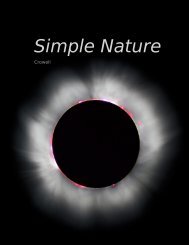Chapter 3 Acceleration and free fall - Light and Matter
Chapter 3 Acceleration and free fall - Light and Matter
Chapter 3 Acceleration and free fall - Light and Matter
You also want an ePaper? Increase the reach of your titles
YUMPU automatically turns print PDFs into web optimized ePapers that Google loves.
Experiments also show that the acceleration is inversely proportional<br />
to the object’s mass, <strong>and</strong> combining these two proportionalities<br />
gives the following way of predicting the acceleration of any<br />
object:<br />
where<br />
132 <strong>Chapter</strong> 4 Force <strong>and</strong> motion<br />
Newton’s second law<br />
a = Ftotal/m ,<br />
m is an object’s mass<br />
Ftotal is the sum of the forces acting on it, <strong>and</strong><br />
a is the acceleration of the object’s center of mass.<br />
We are presently restricted to the case where the forces of interest<br />
are parallel to the direction of motion.<br />
An accelerating bus example 6<br />
⊲ A VW bus with a mass of 2000 kg accelerates from 0 to 25 m/s<br />
(<strong>free</strong>way speed) in 34 s. Assuming the acceleration is constant,<br />
what is the total force on the bus?<br />
⊲ We solve Newton’s second law for F total = ma, <strong>and</strong> substitute<br />
∆v/∆t for a, giving<br />
F total = m∆v/∆t<br />
= (2000 kg)(25 m/s − 0 m/s)/(34 s)<br />
= 1.5 kN .<br />
Some applications of calculus<br />
Newton doesn’t care what frame of reference you use his laws<br />
in, <strong>and</strong> this makes him different from Aristotle, who says there is<br />
something special about the frame of reference attached firmly to<br />
the dirt underfoot. Suppose that an object obeys Newton’s second<br />
law in the dirt’s frame. It has some velocity that is a function of<br />
time, <strong>and</strong> differentiating this function gives dv/dt = F/m. Suppose<br />
we change to the frame of reference of a train that is in motion<br />
relative to the dirt at constant velocity c. Looking out the window<br />
of the train, we see the object moving with velocity v − c. But the<br />
derivative of a constant is zero, so when we differentiate v − c, the<br />
constant goes away, <strong>and</strong> we get exactly the same result. Newton is<br />
still happy, although Aristotle feels a great disturbance in the force.














